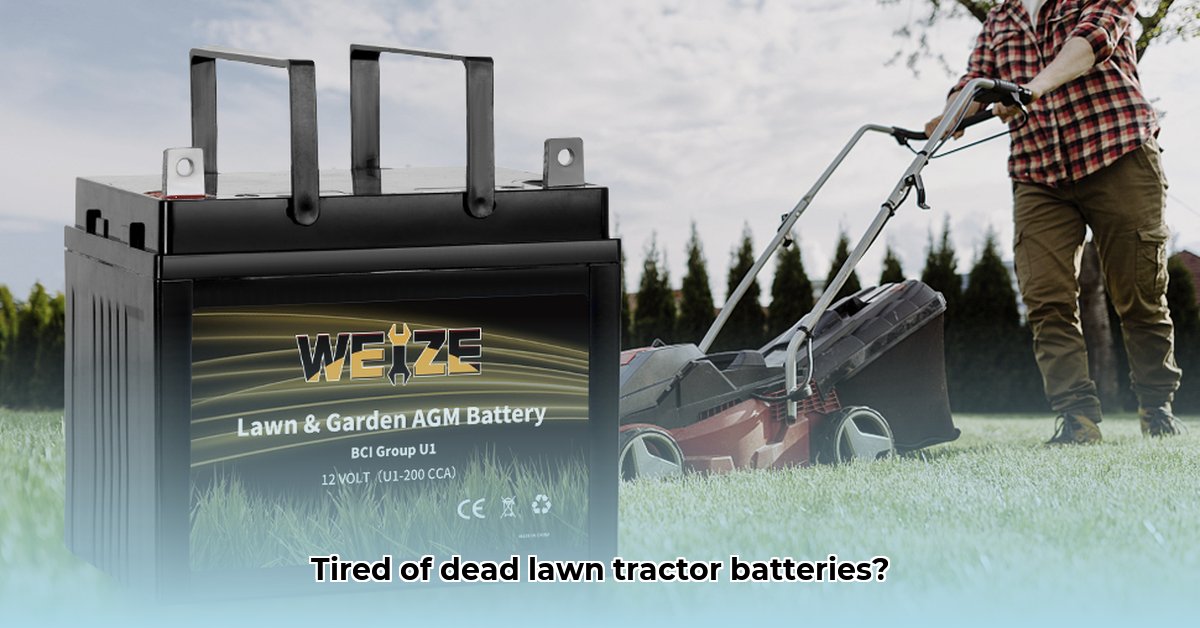
Choosing the right 12-volt battery for your lawn tractor can significantly impact its performance and longevity. A dead battery can halt your work mid-task, costing you valuable time and potentially money. This guide helps you navigate the options, ensuring you select the best battery for your needs and budget. We'll compare AGM and LiFePO4 batteries, guide you through the selection process, installation, maintenance, and proper disposal. For more information on specific battery options, check out this helpful resource on Craftsman lawn tractor batteries.
Understanding Your Needs: Frequency of Use and Climate
Before diving into battery types, consider how often you use your lawn tractor. Daily use demands a robust battery with a longer lifespan and higher cranking power, while occasional use allows for more budget-friendly options. Your climate also plays a role; extreme temperatures can impact battery performance. Cold weather, for instance, significantly reduces the effectiveness of many AGM batteries. Do you need a high CCA (Cold Cranking Amps)?
AGM vs. LiFePO4: A Detailed Comparison
Two primary battery types dominate the market: Absorbent Glass Mat (AGM) and Lithium Iron Phosphate (LiFePO4). Let's examine their key differences:
| Feature | AGM (Absorbent Glass Mat) | LiFePO4 (Lithium Iron Phosphate) |
|---|---|---|
| Cost | Lower initial cost | Higher initial cost |
| Lifespan | Typically 3-5 years | Significantly longer, often 8 years or more |
| Weight | Heavier | Much lighter |
| Charging Time | Longer charging time | Much faster charging time |
| Environmental Impact | Contains lead-acid, requiring responsible recycling | Generally more environmentally friendly due to less toxic components |
| Durability | Susceptible to damage from extreme temperatures and vibrations | More resistant to extreme conditions and vibrations |
| Maintenance | Requires periodic water level checks (for flooded types) | Minimal maintenance required |
AGM Batteries: The Dependable Choice
AGM batteries are a widely available and familiar option. Their lower initial cost makes them attractive to budget-conscious buyers. However, their shorter lifespan means more frequent replacements, increasing long-term expenses. They are also heavier, making handling and installation slightly more challenging. Dr. Anya Sharma, Professor of Engineering at the University of California, Berkeley, notes, “AGM batteries offer reliable performance for moderate use, but their shorter lifespan should be factored into the overall cost analysis.”
LiFePO4 Batteries: The High-Performance Option
LiFePO4 batteries represent advanced battery technology. While their upfront cost is higher, their significantly longer lifespan often offsets this over time. Their lighter weight and faster charging times are significant advantages. Moreover, their superior performance in extreme temperatures improves reliability in various climates. However, availability may be more limited in some areas. As John Miller, Lead Engineer at GreenTech Batteries, explains, “LiFePO4 batteries offer a compelling long-term value proposition, particularly for users who prioritize longevity and reduced maintenance."
Selecting the Right Battery: A Step-by-Step Guide
Step 1: Consult Your Owner's Manual: Your lawn tractor's manual specifies the correct battery size and type. This ensures proper fit and optimal performance.
Step 2: Assess Your Usage: Frequent use justifies the investment in a longer-lasting LiFePO4 battery. Infrequent use may make an AGM battery a more cost-effective choice.
Step 3: Compare Lifecycle Costs: Consider the initial cost, lifespan, replacement frequency, maintenance, and disposal costs of each type. A simple spreadsheet can help you quantify long-term expenses.
Step 4: Installation: Carefully follow the manufacturer's instructions for safe and secure battery installation.
Step 5: Preventative Maintenance: Regularly clean battery terminals and ensure adequate ventilation to prevent corrosion and gas buildup.
Step 6: Responsible Disposal: Dispose of your used battery according to your local regulations to protect the environment.
Key Considerations and Frequently Asked Questions
Q: How do I choose between a flooded AGM and a sealed AGM battery?
A: Sealed AGM batteries are generally preferred for their maintenance-free operation and reduced risk of spillage, making them ideal for lawn tractors.
Q: What are the environmental implications of each battery type?
A: AGM batteries contain lead acid, requiring responsible recycling. LiFePO4 batteries are more environmentally friendly due to less toxic components. However, responsible sourcing and recycling of the lithium is crucial.
Q: What is the impact of temperature extremes on battery performance?
A: Extreme cold significantly impacts AGM battery performance. LiFePO4 batteries generally exhibit better performance in cold weather.
Q: How often should I charge my lawn tractor battery?
A: This depends on usage, but letting the battery discharge completely should be avoided. Regular charging, particularly after each use, is recommended.
By carefully considering these factors and following the steps outlined in this guide, you can choose the 12-volt battery that best suits your needs, ensuring your lawn tractor stays powered up and ready for action, season after season.